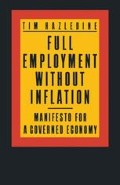Abstract
The previous two chapters pointed out the potential for much lower unemployment, and argued that, in principle, this could be achieved without having to trade-off unemployment for higher inflation. In this chapter, it will be suggested that opportunities for improved economic performance exist at all levels of the economy.
Access this chapter
Tax calculation will be finalised at checkout
Purchases are for personal use only
Preview
Unable to display preview. Download preview PDF.
References
F. M. Scherer, Industrial Market Structure and Economic Performance, 2nd ed (Rand McNally, 1980) p. 469. For analysis of price umbrellas in Canadian industries, see Tim Hazledine, ‘The Possibility of Price Umbrellas’, International Journal of Industrial Organisation, 1984 (forthcoming).
Harvey Leibenstein, ‘Allocative Efficiency vs. “X-Efficiency”’, American Economic Review (June 1966). See also Scherer, Industrial Market Structure …, pp. 464–6, and Hay and Morris, Industrial Economics: Theory and Evidence (Oxford University Press, 1979), pp. 557–62.
Keith Cowling. Monopoly Capitalism (Macmillan, 1982), p. 86–7. Cowling criticises several earlier studies which did not control statistically for monopoly power, since in highly competitive industries all firms must be of about equal profitability to survive. That is, only in industries with significant market power will there be the slack, the room to manoeuvre, that permits sizeable differences in reported profits to emerge.
G. D. Newbould, Management and Merger Activity (Guthstead, Liverpool, 1970); cited by Cowling, Monopoly Capitalism, p. 81.
J. K. Galbraith, Economics and the Public Purpose, and The Affluent Society (1958, reprinted by Penguin Books).
Tim Hazledine, The Costs of Protecting Jobs in 100 Canadian Manufacturing Industries, Labour Market Development Taskforce Technical Study No. 16 (Ottawa, 1981).
B. Klotz, R. Madoo, and R. Hansen studied the US firm-level data, and uncovered cost differentials similar in magnitude to those reported here for Canada. See ‘A Study of High and Low Labor Productivity Establishments in US Manufacturing’, in J. Kendrick and B. Vaccara (eds), New Developments in Productivity Measurement and Analysis (National Bureau for Economic Research, Studies in Income and Wealth, vol. 44, University of Chicago Press, 1980).
Copyright information
© 1984 Tim Hazledine
About this chapter
Cite this chapter
Hazledine, T. (1984). In Search of Band-X. In: Full Employment without Inflation. Palgrave Macmillan, London. https://doi.org/10.1007/978-1-349-17697-7_9
Download citation
DOI: https://doi.org/10.1007/978-1-349-17697-7_9
Publisher Name: Palgrave Macmillan, London
Print ISBN: 978-0-333-36984-5
Online ISBN: 978-1-349-17697-7
eBook Packages: Palgrave Economics & Finance CollectionEconomics and Finance (R0)

